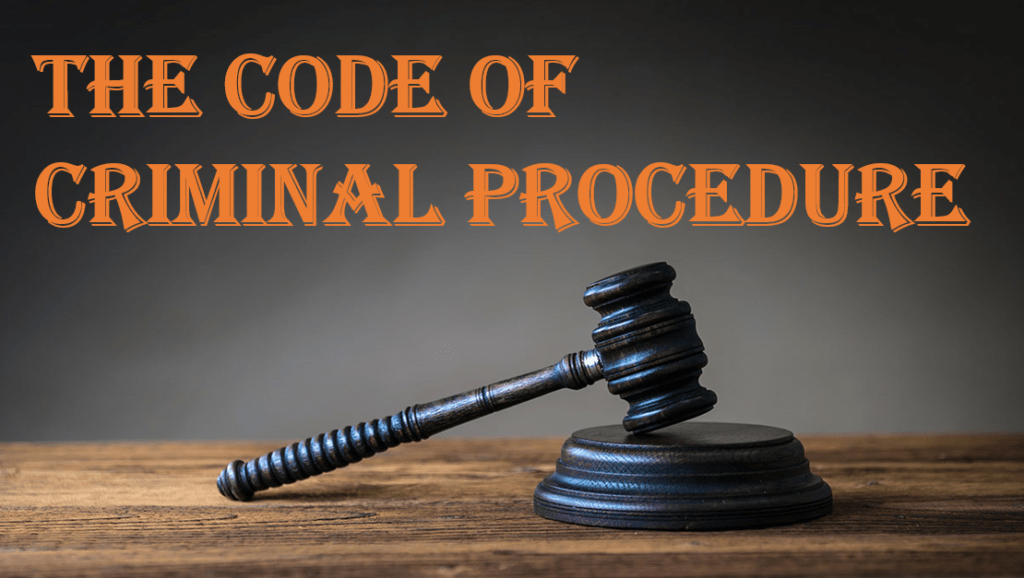
This article is written by Nalluri Chetan of 5th Semester of VIT AP School of Law, an intern under Legal Vidhiya
Abstract
As we all know, crimes occur on a regular basis in society. And we have different punishments for different crimes committed, which are clearly described in the Indian penal code, which has now been known as the Bharatiya Nyaya Sanhita. Knowing the punishment will not solve the problem. Before punishment, a framework is established to establish how to arrest someone, how the investigation should go, who will represent the victim, and which court is competent to hear the case. And What is the procedure from the time of arrest to the application for bail or conviction? They are covered under the Code of Criminal Procedure; however, the government has changed the name to Bharatiya Nagarik Suraksha Sanhita. So, in this article, I will primarily look at what the Code of Criminal Procedure is, and its importance in society.
Keywords: Crime, Arrest, Punishment, Code of Criminal procedure
Introduction
Prior to India’s independence and the implementation of its constitution, the British dominated India, and their laws were ultimate, and no one could even argue them. If anybody questions them, they will be arbitrarily detained and abused in detention with inhumane punishment. So, in order to prevent all of the complications associated with unlawful arrests as well as other procedural issues associated with arrest and punishment, the Code of Criminal Procedure law was enacted. The Code of Criminal Procedure was first approved in the British Parliament in 1861, and in 1882, it established unified criminal law for both the presidency towns and mofussil. It was again replaced by the 1898 Code of Criminal Procedure Then, in 1972, based on the 5th Law Commission, 41st report the Code of Criminal Procedure was updated and put into effect, and it is now officially known as the Code of Criminal Procedure 1973. However, the national government has renamed the code of criminal procedure to Bharatiya Nagarik Suraksha Sanhita. With a few fresh sections as well as some updated sections. The major goal of having a Code of Criminal Procedure is to have a codified criminal law.
Because there was no defined system for how to investigate a person and how to arrest a person during the British era, and there were no rights for the accused, So, in order to eliminate any arbitrariness in the arrest and other procedural concerns, the act came into existence. Everything changed once the criminal procedure law came into existence. Before the police had so much authority, the police had every right to arrest someone, but today the police cannot do anything they want; everything they do must be legal, or they would be penalised.
Importance of code of criminal procedure
There is a significant amount of importance to the code of criminal procedure. Ordinary individuals cannot comprehend the significance of the criminal process law unless they are victims. Even though ordinary people are unaware of the significance at first, they may become aware after suffering. Particularly those who have been wrongfully charged will understand the significance of the criminal procedure law.
The most important aspect of criminal procedural law is how the arrest should be carried out, as well as the grounds for the arrest. As we all know, illegal arrests occur in all societies without any complaints simply because of political pressure or because someone who spoke out against injustice in society will be imprisoned and tortured. Following all of these atrocities done by police officers in the case of Arnesh Kumar vs. State of Bihar[1], the Supreme Court said clearly that arrest is an exception and that offences where the punishment is less than seven years shall be handed a notice under Section 41A.
Section 41A Code of Criminal Procedure says that a Notice of appearance before a police officer. After issuing the 41 A notice, the person accused can be investigated first and then arrested if necessary because if he is outside, he may injure people or fabricate evidence. For these reasons, the accused should be held before a magistrate for permission to arrest. If the magistrate feels satisfied with the arrest, the magistrate should prepare a proper report explaining why the accused should be detained before allowing the police to arrest the accused. This provision prevents unlawful arrests and assists those who are arrested illegally.
Rights of Accused
- The Code of Criminal Procedure also guarantees accused persons rights from the moment they are arrested, including the right to know why they were arrested, as stated explicitly in Section 50(1) of the Code of Criminal Procedure.
- In the case of Joginder Kumar vs. State of Uttar Pradesh[2], it is explicitly stated that an arrest should not be made only because it is legal for the police officer. It should be done only after reasonable satisfaction and inquiry so that the accused’s liberty is not denied and the accused knows why he had been arrested if the investigation is conducted properly.
- Except for non-bailable offences, the police have a duty to advise the accused that he has a right to be released on bail, commonly known as station bail so that he can arrange for sureties, as stated in Section 50(2) of the Code of Criminal Procedure.
- Section 57 of the Criminal Procedure Code states clearly that an accused who has been arrested must appear before a magistrate within 24 hours unless there are extraordinary circumstances. So that he cannot be abused and so that he may be saved if there is any abuse in the custody.
- The accused has every right to go to court if he believes he has been wrongfully charged with crimes. If he believes he may be arrested on false allegations, he can apply to the court for anticipatory bail under Section 438 of the Code of Criminal Procedure so that he can avoid arrest where the court may order the police if the offence is less than seven years to follow 41A notice of Code of Criminal Procedure If the offence is more serious, the court may grant an anticipatory bail by imposing some conditions.
- The importance of the accused’s health and safety is strongly emphasised in section 55 of the Code of Criminal Procedure. According to this section, the accused shall be given appropriate care while being in custody and should be in a safe position.
- According to Section 303 of the Code of Criminal Procedure, every accused person has the right to retain his or her own attorney to represent them in court.
- In the case of Khatri v. State of Bihar[3], Justice P.N. Bhagwati stated clearly that the accused should be informed of his right to legal aid if he lacks the resources to keep an advocate. This will allow him to defend himself through legal counsel. Every accused has the right to legal aid at the expense of the state when the accused has no sufficient means to have an advocate which is clearly stated under section 304 of the Code of Criminal Procedure which says legal aid to accused at state expenses in certain cases.
- Apart from this Accused has a right under section 41D of the Code of Criminal Procedure Which Says the Accused has the right of the arrested person to meet an advocate of his own choice During the interrogation.
- The accused has the right to get compensation. It is explicitly stated in the Code of Criminal Procedure under section 358 which says that compensation to persons groundlessly arrested. So that a person who is arrested can seek compensation if the magistrate believes he was arrested unlawfully and has committed no offence.
The above are a few of the rights granted to accused persons under the Code of Criminal Procedure demonstrating the importance of a criminal procedural law.
Rights of victims
- The Code of Criminal Procedure is essential in protecting the victim’s rights. The major right that the victim has, or that may be the obligation of the state, is that the state will represent the victim in court as a public prosecutor under section 24(8) of the Code of Criminal Procedure, ensuring that there is no possibility of unfairness. Because the state is aware of the issue, the victim’s safety is increased.
- The victim has the right to be compensated under Section 357 of the Code of Criminal Procedure, which states that the accused who has been convicted by the court for the offence must compensate the victim for the damage that the victim has suffered.
However, in the case law of Harikishan and the state of Haryana vs. Sukhbir Singh[4], The Supreme Court explicitly underlined its dissatisfaction with the improper implementation of Section 357. And victims are rarely compensated.
- The victim is entitled to compensation under Section 357 A of the Code of Criminal Procedure, which specifically mentions the victim compensation programme. The state government, in collaboration with the central government, develops a plan for giving funds to compensate victims or defendants who have suffered loss or harm as a result of crime and require rehabilitation. This section applies only when the trial court concludes that the compensation awarded is insufficient, or when the accused is not traced but the victim is identified as there is no chance for trial so that the victim can receive compensation under this section.
- The Code of Criminal Procedure section 357 C explicitly states that anybody who has been the victim of rape or acid attacks would be treated for free at state and federal government hospitals, so that anyone who is deprived and cannot afford treatment can go to government hospitals so they can get it.
- The victim has the right to file an appeal if he or she is dissatisfied with the court’s decision, whether acquittal or conviction for the offence committed, as stated in Section 372 of the Code of Criminal Procedure.
Fair and Speedy Trial
In order to administer justice in a transparent and equitable manner, the Code of Criminal Procedure is crucial. We are all aware that achieving justice for individuals depends on having an effective system for operating courts, which is only possible with good court administration. Different courts were specifically given administrative authority under the Code of Criminal Procedure. The courts’ classification for different sorts of offences is clearly stated in the Code of Criminal Procedure. Section 6 of the Code of Criminal Procedure discusses different types of criminal courts. The chance of receiving prompt justice or exercising one’s right to a speedy trial under Article 21 of the Indian Constitution is raised as a result of the categorization of courts.
Conclusion
In conclusion, the Code of Criminal Procedure is a vital cornerstone of any contemporary legal system, organising complex justice through its well-defined procedures, safeguards, and principles. It encompasses the core of due process, ensuring that the accused are treated fairly, individuals’ rights are protected, and the legal system runs efficiently. The Code of Criminal Procedure promotes openness, uniformity, and accountability within the criminal justice system by establishing the norms for investigation, prosecution, trial, and appeal. Its importance stems not just from its ability to prevent abuse of power, but also from its function as a defender of individual liberty. As societies change, the CrPC adapts, balancing the scales of justice and reaffirming the rule of law.
References
- indianlegalsolution.com/arrest-how-made-arrest-by-magistrate-and-procedure-for-investigation-detailed-discussion
- www.studymode.com/v1/turnitin_essay/1589749
- www.telegraphindia.com/1160804/jsp/frontpage/story_100527.jsp
[1] 2014 8 SCC 273
[2] 1994 SCC (4) 260
[3] 1981 SCC (1) 627
[4] 1988 AIR 2127




0 Comments